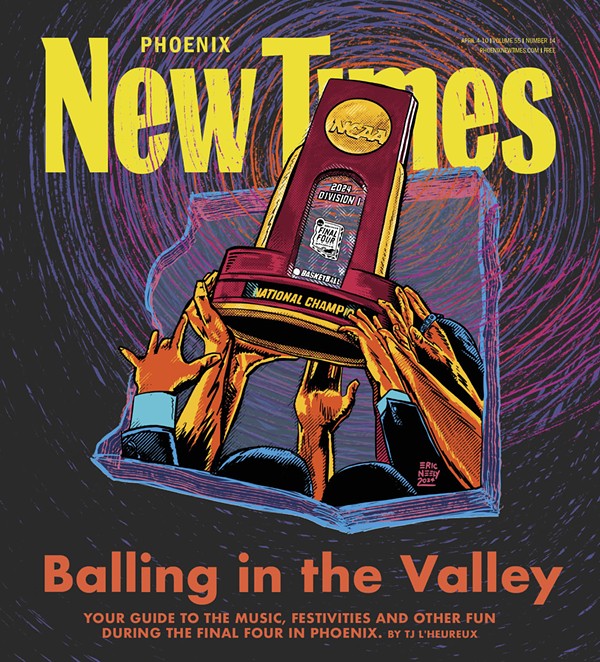Ofstedahl, 37, is best known as an advocate, the decorated journalist and essayist who turned Echo magazine into a credible voice for Arizona's homosexuals.
First and foremost, however, Ofstedahl is a patriot, a true believer in American ideals.
We are chatting at a coffee shop, and as Ofstedahl waxes wholesome, I half expect Kate Smith to burst onto the patio and belt out "God Bless America."
Yet Ofstedahl's principles are genuine. He wears a leather bomber jacket bearing the insignia "Bering Sea Bandits." He looks and speaks like any former military man -- a seeming incongruity in someone who has railed convincingly against narrow Yankee mores.
In fact, he explains, his bedrock faith in God and country kindled his gay activism.
"The Navy trained me to be a gay activist," he says.
And before he ever spoke out for gay rights or funding to fight AIDS, those principles inspired him to risk his life as a military intelligence officer.
During the 1980s -- at the height of Cold War frigidity -- Ofstedahl was a Russian-language specialist. He was assigned to an airborne surveillance route 100 kilometers off the northeast coast of the Soviet Union. He listened to Soviet military radio traffic, scribbled notes and interpreted them for Navy intelligence.
The term "spy plane" is an unfortunate misnomer, he explains. He and his Navy colleagues were not spying. Espionage implies unlawful acts, he says, and there was nothing illegal about their missions. Such flights remain in international airspace. The airwaves belong to everyone.
His eavesdropping sorties, made every other day, were grueling 12- to 14-hour affairs.
"Hours of absolute boredom," he says, "interspersed with moments of sheer panic."
His experiences mirror those of the 24 Navy crew members whose damaged plane landed on Hainan after it collided with a Chinese fighter jet. The fighter pilot apparently was killed.
The lumbering EP-3s on which Ofstedahl flew -- they're known affectionately as "sky pigs" -- were constantly shadowed, and frequently menaced, by Soviet fighter jets.
"We were in the Cold War with the Soviets," he says. "Up there, it wasn't very cold. It was heated daily."
The MiG pilots made sport of playing "tag," touching their wingtips to the propeller-powered EP-3s.
They banked within feet of the U.S. craft, giving everyone aboard a chilling view of the missiles mounted on their bellies.
"They were so close you could see the color of the pilot's eyes," he says. "You could tell whether he shaved that morning."
They crept up beneath the surveillance craft, then popped up just yards ahead of the EP-3's nose cone and thrust on their afterburners.
"We called it 'thumping,'" he says. "The turbulence would just shake and buckle the plane, and it felt like it was coming apart at the seams.
"There were many times that I honestly didn't think we would make it back."
"Thumpings" frequently left crew members with broken bones, sprains and concussions, he says.
Although the EP-3s being flown today are older than Ofstedahl, he says they are immaculately maintained. And they tote such sophisticated equipment, there's no chance that one would inadvertently stray into forbidden airspace.
"We knew exactly where we were 1,000 percent of the time," he says. "The question was, where did they think we were at? There were some incidents where the Soviets thought we had entered their airspace. We'd head home. We'd get the hell out of Dodge."
He pauses to leaf through an album of photos he took during reconnaissance flights, startling shots in which rivets on the fuselages of MiGs are discernible. There also are pictures of Soviet aircraft carriers and other warships.
Like the Chinese and the Soviets, the U.S. also sends fighters up to escort reconnaissance craft near our shores.
Fighter pilots are the glamour fliers. Ofstedahl chuckles and suggests that a movie about an EP-3 would have to be dubbed "Top Prop."
Yet he is convinced it takes more fortitude to board an electronic data sponge -- an unarmed "giant antenna, a flying tape recorder" -- and withstand the taunts of rogue fighter jockeys, all the while under radar lock from surface-to-air missile batteries. Few fighter pilots ever make aerial eye contact with a potential rival. Ofstedahl has done it hundreds of times.
While U.S. fighter jets fly in dramatic formation over bowl games, Ofstedahl and his crewmates -- the EP-3 carried 32 at that time -- couldn't tell anyone about their jobs or even confirm that they flew anywhere.
Such perilous obscurity required a dedication and camaraderie that made an indelible impression on Ofstedahl.
"These people are highly trained professionals," he says. "They do this job because they believe in something larger than themselves. They believe in God and country. They believe the ideals of democracy are worth fighting for.
"It's their faith in these ideals and faith in each other that are getting them through this ordeal," he says of the 24-member crew being held by Chinese authorities.
None of his surveillance flights ever garnered the attention of the Chinese, but Ofstedahl says the eavesdropping cognoscenti claim that China's fighter pilots are taught a tactic that involved shearing off the wing of a reconnaissance plane while simultaneously ejecting from their own craft. Bring down a plane without firing a shot.
Political events and military posturing were good indicators of what Ofstedahl could expect on any given day above the icy seas off the USSR.
"If our military did something to provoke them in any way, they'd take it out on us," he says.
Such retribution may explain why Wang Wei, the Chinese pilot who apparently died in the collision, made three passes at the EP-3 on April 1. Wei has been called a "cowboy" -- a pilot known for his aggressive tactics.
Tensions have risen over a sterner diplomatic line adopted by the Bush administration, and especially over a pending decision on the sale of sophisticated anti-missile technology to Taiwan, which China views as a renegade province.
In January, the United States complained to the Chinese government about increasingly belligerent actions by Chinese fighter pilots. To no avail.
Ofstedahl refuses to question the pilot's decision to land on Hainan.
"The only reason they landed on Chinese soil is that they were going to crash," he says. "They couldn't make it" to a U.S. base in Japan.
The plane may have been upgraded with a new generation of sensing gear recently, according to Jane's Military News.
Ofstedahl believes the crew on the damaged plane was able to destroy classified data and equipment before it touched down on Hainan. Some devices are set up for easy and quick destruction. If there's time, crew members are instructed to throw items off the plane, he says.
"I'm confident that they concluded their destruction procedures, because if they hadn't, they probably would have ditched the plane at sea," he says.
Under that scenario, he explains, "You land on the water and you hope to God that the plane stays intact long enough that everyone could jump out and get into life rafts."
Life expectancy in the sea at northern latitudes is five minutes.
Though he and his colleagues knew the danger inherent in the aerial games of cat-and-mouse, Ofstedahl says seeing the so-called enemy at such proximity -- even during Ronald Reagan's "Evil Empire" era -- provided lessons in humanity.
"It's so easy to demonize the enemy," he says. "But when you see that enemy face to face, you see that he's just a guy. You start to wonder about these people as real individuals. You start to realize that the only thing that separates his life from my life are lines on a map."
Ofstedahl clearly relished his time as an aerial snoop. But it was during his Navy years that he came to the realization that he was gay -- and the military is not an easy place to be homosexual.
"One of my disillusions was that I thought I was up there fighting for freedom for everybody," he says. "I wanted to make it a career."
But he knew that if he were to become sexually active, that career could be dashed in an instant.
"You know in your heart that [sexual orientation] shouldn't matter, that it should be the quality of your contribution," he laments. "You believe the system is going to be just for you, because you've done so much for the system."
After seeing other highly rated sailors humiliated and drummed out of the service because they were gay, he chose to keep his orientation a secret and refrain from fraternization. Ultimately, despite his own stellar performance ratings, he chose to leave the Navy.
He returned to his hometown, came out of the closet and became a crusading journalist. Though he still writes columns for Echo magazine, he is no longer in management there. He makes his money selling products to grocery stores.
He sighs.
"There hasn't been a day that's gone by that I haven't wished I was still flying," he says.










